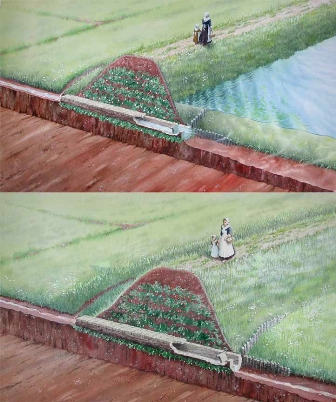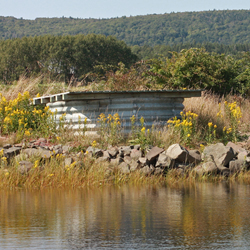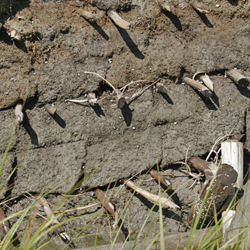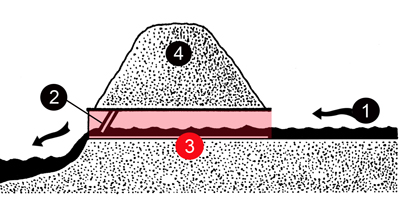Dykeland agriculture
Melanson Settlement National Historic Site

Dykeland system
The dykeland system in Nova Scotia began with Charles de Menou d’Aulnay in the 1630s who applied a technique similar to one long used in France. The concept entailed constructing earthen dykes along a tidal river or bay to prevent salt water from flooding the marshland. At low tide, a system of canals, streams and dykes allowed freshwater to flow through sluices (aboiteaux) in the dykes made from hollowed logs or planks and out to sea. At high tide, a wooden valve at the river end of the sluice closed as the tide rose, preventing the sea water from entering the marshland. Within a few years, rain and melting snow leached out most of the salt, creating a fertile plain where farmers could cultivate crops such as wheat, oat and flax.
Roads in farming areas often led along the tops of dykes. Carts drawn by oxen or horses were used for local travel. The dykeland system has survived throughout the centuries. Today, thousands of hectares of agricultural land along the Bay of Fundy coast in Nova Scotia are maintained as dykelands, based on the concept brought here by d’Aulnay and his settlers.


Dykeland Construction
A) Aboiteau at low tide

1. Flow of fresh water from the marsh
2. Clapper valve opened by the pressure of the flow of the fresh water
3. Sluice (aboiteau)
4. Dyke
B) Aboiteau at high tide

1. The drained marsh is below sea level
2. Clapper valve closed to prevent salt water from entering the dyked area
3. Sluice (aboiteau)
4. Dyke
Resources
BLEAKNEY, J. Sherman. Sods, soil, and spades: the Acadians at Grand Pré and their dykeland legacy, McGill University Press, 2007.
Nova Scotia Department of Agriculture and Marketing, Maritime Dykelands: the 350 year old struggle, 1987.
- Date modified :